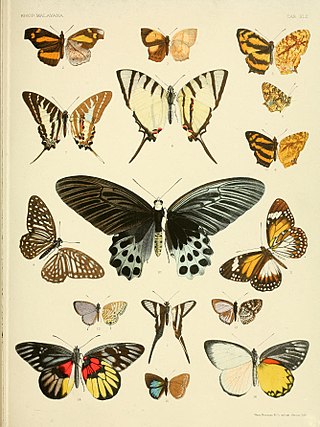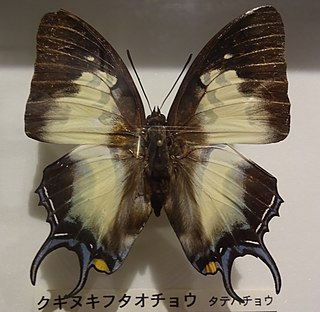
Ampittia dioscorides, the common bush hopper or simply bush hopper, is a species of butterfly found in India, China, Indochina, Cambodia and on to Borneo, Sumatra and Java belonging to the family Hesperiidae.

Pseudocoladenia dan, commonly known as the fulvous pied flat, is an Indomalayan species of butterfly in the family Hesperiidae. It is found from India to southeast Asia.

Graphium macareus, the lesser zebra, is a relatively common and not threatened species of swallowtail butterfly found in Southeast Asia. It is also found in parts of India including Assam and Sikkim.

Moduza procris, the commander, sometimes included in the genus Limenitis, is a medium-sized, strikingly coloured brush-footed butterfly found in South Asia and Southeast Asia. It is notable for the mode of concealment employed by its caterpillar and the cryptic camouflage of its pupa.

Hebomoia glaucippe, the great orange-tip, is a butterfly belonging to the family Pieridae, that is the yellows and whites. It is found in the Indomalayan realm and Wallacea.

Euploea crameri, the spotted black crow, is a butterfly found in Asia that belongs to the crows and tigers, that is, the Danaid group of the brush-footed butterflies family.

Polyura arja, the pallid nawab, is a butterfly belonging to the rajahs and nawabs group, that is, the Charaxinae subfamily of the brush-footed butterflies family.

Polyura eudamippus, the great nawab, is a butterfly found in India and the Indomalayan realm that belongs to the rajahs and nawabs group of the brush-footed butterflies.

Polyura delphis, the jewelled nawab, is a butterfly found in India and Southeast Asia that belongs to the rajahs and nawabs group, that is, the Charaxinae subfamily of the brush-footed butterflies family. The front wings have a concave outer edge and hind wings bear two tails.The upperside is white, largely marked with brown at the apex of the forewings. The reverse is metallic white decorated with yellow chevron lines and red marks. The wingspan is about 2.75 inches (70 mm).

Miletus symethus, the great brownie, is a small butterfly found in India that belongs to the lycaenids or blues family. The species was first described by Pieter Cramer in 1777.

Arhopala eumolphus, the green oakblue, is a lycaenid butterfly found in the Indomalayan realm. The species was first described by Pieter Cramer in 1780.

Arhopala bazalus, the powdered oakblue, is a lycaenid or blue butterfly first described by William Chapman Hewitson in 1852. It is found in Myanmar, mainland China, India, Indochina, Japan, the Philippines, and Taiwan.

Iraota rochana, the scarce silverstreak, is a species of lycaenid or blue butterfly with several subspecies found in Manipur, Myanmar, Java, Borneo, Sumatra, Malaya, Langkawi, Thailand, Singapore, Sulawesi and the Philippines. The species was first described by Thomas Horsfield in 1829.

Papilio iswara, the great Helen, is a species of large swallowtail butterfly found in parts of Southeast Asia.

Atrophaneura sycorax is a species of butterfly from the family Papilionidae that is found from southern Burma to Peninsular Malaysia, and in Sumatra and western Java.

Arhopala aedias, the large metallic oakblue, is a species of butterfly belonging to the lycaenid family described by William Chapman Hewitson in 1862. It is found in Southeast Asia.

Arhopala ammonides is a species of butterfly belonging to the lycaenid family described by William Doherty in 1891. It is found in Southeast Asia.

Polyura jalysus, the Indian Yellow Nawab, is a butterfly in the family Nymphalidae. It was described by Cajetan Felder and Rudolf Felder in 1867. It is found in the Indomalayan realm.

Charaxes (Polyura) dehanii is a butterfly in the family Nymphalidae. It was described by John Obadiah Westwood in 1850. It is found in the Indomalayan realm in Java and Sumatra.

Arhopala phaenops, is a butterfly in the family Lycaenidae. It was described by Cajetan Felder and Rudolf Felder in 1865. It is found in the Indomalayan realm.





















